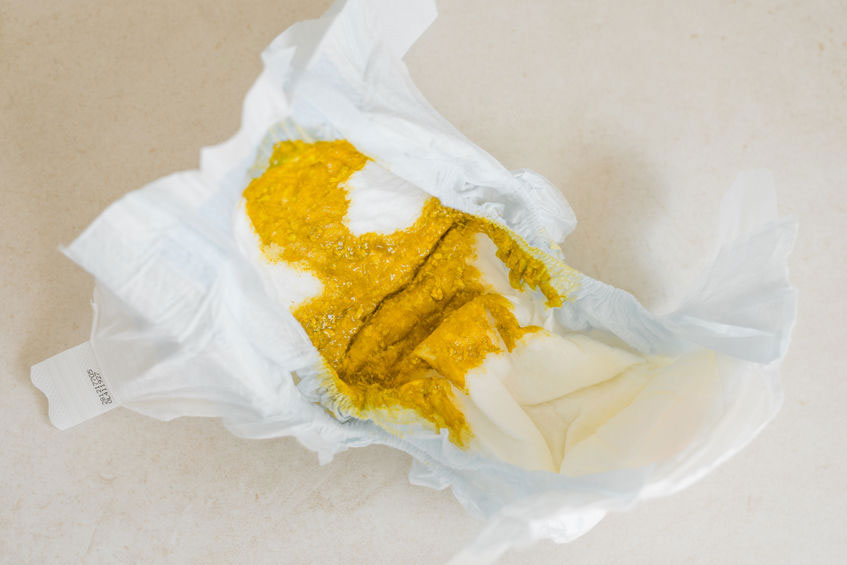A common worry among breastfeeding mothers is whether their baby is getting enough milk because they can’t see how much they have drunk. Also, because breast milk is very quickly and easily digested—it can be digested in one hour 1—a breastfed baby might ask to breastfeed again (and again) even though they were just fed, causing mothers to worry about their milk supply. Fortunately there are several ways for parents to check whether their babies are getting enough milk:
#1 Milk coming in
Immediately after your baby is born your breasts will only contain small amounts of colostrum (the first breast milk). These small volumes are perfect for your healthy newborn baby to learn to breastfeed and will keep them hydrated.2 Most mothers notice their milk “comes in” (increases in volume) around two to three days after their baby is born. Breasts will feel fuller, heavier and warmer and you may notice one breast leaking while your baby feeds from the other side. When your baby is feeding well, breastfeeding should be comfortable and your breasts will feel fuller before a feed and softer after your baby has suckled.
If you haven’t noticed a feeling of your milk coming in by the fourth day, ensure your baby has been weighed and checked by a health professional 3 and contact your breastfeeding specialist to check for any potential reasons for a delay in your milk supply.
#2 Breastfeed often
Your baby is trying to double his weight in the first few months of life so he needs plenty of breast milk to do that. The more often you breastfeed (with good positioning and plenty of swallows) the more milk will be made. Follow your baby’s lead even if he has only fed half an hour ago. In the early weeks your little one will breastfeed at least 8 to 12 times in a 24 hour period, including night feeds which are very important. A baby can take a large proportion of their calories at night. See One Breast or Two Per Feed? to explain whether to offer one breast or both at each feed and How Often Should a Newborn Feed?
Early feeding cues
Crying is a late sign of hunger so offer a breastfeed as soon as you see early feeding cues like fidgeting, rooting (head turning with an open mouth searching for the breast) and sucking fingers and fists. If you’re worried that He Can’t Be Hungry He Only Just Ate! He can!
Cluster feeds
It is normal for some babies to cluster feed i.e. they seem to want to feed all the time at certain times of the day, for example during the evening and during growth spurts. The closer together the feeds the higher the fat content of all the milk and the higher its calorific value.
Remind a sleepy baby to breastfeed
You may need to remind a sleepy baby to feed every couple of hours or 10 to 12 times in 24 hours. Hold him skin-to-skin and encourage latching on during periods of light sleep and as soon as he begins to wake. You could try breast compression (gentle breast massage during a breastfeed) and switch nursing (swapping breasts as soon as milk flow slows on one side) to keep him feeding. For more tips see Breastfeeding a Sleepy Baby.

#3 Look and listen for swallowing
When your baby is breastfeeding well you will see his jaw moving vigorously throughout the feed (expect this to be at least ten minutes or more on each breast) and you will either hear him swallowing, or see the pause in his suck while he swallows breast milk. Dr Jack Newman, a Canadian paediatrician and breastfeeding specialist explains:
When a baby is getting milk (he is not getting milk just because he has the breast in his mouth and is making sucking movements), you will see a pause at the point of his chin after he opens to the maximum and before he closes his mouth, so that one suck is (open mouth wide > pause > close mouth type of sucking).
If you can’t hear or see your baby swallowing milk and they appear to be mostly just sleeping at the breast, or if breastfeeding is painful, seek breastfeeding help from an IBCLC lactation consultant as soon as possible.
#4 Plenty of dirty nappies

What goes in must come out! If your baby is swallowing plenty of breast milk there will usually be plenty of breastfed baby poop to match. A newborn baby’s poo changes colour in the first few days of life from black meconium (the first poop) to soft yellow poo. After day four or five, three or more soft yellow or mustard coloured poos each day are usually a good sign that your baby is swallowing plenty of milk. In addition, at least five or six wet nappies (diapers) per day, with pale coloured urine alongside the dirty ones, show your baby is well hydrated.4 Wet nappies on their own are not usually confirmation that your baby is getting enough milk in the first six weeks. Nappies with red marks or a “brick dust” appearance after the fourth day, or poo that has not changed colour by this time could be signs your baby isn’t getting enough milk, contact your baby’s doctor and seek help with breastfeeding.
See Breastfed Baby Poop for more information about the amount of poop to expect as your baby grows and the colour changes that are normal during the first five days.
Weigh alongside
Although counting dirty nappies can be useful it should not replace weighing your baby regularly (see below). Some studies found diaper output alone was not a reliable guide to milk intake and that stool patterns could change over time.5
#5 Look for signs of satiety

Signs that your baby is full include his falling asleep or letting go of the breast of his own accord after about 10-30 minutes of active sucking and swallowing. There is no need to time it, and he may need to feed again quite soon, but when he has had enough milk he will usually be very relaxed with open hands and a relaxed expression, often described as looking “milk drunk”. Conversely, a hungry baby tends to hold himself quite tensely with clenched fists, arms bent and a worried expression. A hungry baby may try to feed constantly and never seem satisfied or sometimes he may sleep all the time and not have enough energy to feed.
Avoid a dummy
Avoid giving your baby a dummy or pacifier until breastfeeding is well established otherwise you might miss feeding cues and your baby may not get enough feeds.
#6 Monitor your baby’s weight
Weighing your baby regularly on baby scales will confirm that your baby is growing as expected.
The first two to four days
It is normal for a breastfed baby to lose a little weight before his mother’s milk comes in during the first two to four days of life and babies are well equipped for this. A weight loss of up to 7% birth weight is frequently accepted as normal.67 One systematic review found weight loss is commonly 7% to 8% of birth weight or greater by the third day after birth among healthy, full-term, breastfed newborns.8 If your baby has lost more than 7-8% of their bodyweight, or is still not gaining weight after 3‑4 days, your doctor will check your baby and a breastfeeding specialist can review how breastfeeding is going and maximise your baby’s milk intake.
After the first few days
Once your milk has come in, average weight gains of 30‑40g per day (or 7‑10 ounces per week) can be expected in the first three months of life based on the World Health Organization (WHO) weight-for-age charts. The World Health Organisation charts reflect growth patterns among breastfed children, see weight-for-age 0‑6 month curves GIRLS & BOYS. Most babies will have regained their birth weight by by 10 to 14 days after birth (DiTomasso and Cloud, 2019). Weight gain slows down between 3‑6 months to an average gain of 20g per day.

Regular weights
Getting a weekly weight check on the same scales (if possible) and plotted on your baby’s WHO growth chart will show how your baby is growing. Advice to weigh monthly is only appropriate once your baby is thriving and gaining weight and you know breastfeeding is going well. However, a month is too long to leave a baby who is hardly gaining, not gaining or who is losing weight. If your baby is not gaining weight in the normal range stay in touch with your health professional to rule out any underlying medical conditions, contact a breastfeeding specialist for support and see Baby Not Gaining Weight and Understanding Your Baby’s Weight Chart for further information. The earlier you seek help the easier it will be to protect your breast milk supply and the quicker to get breastfeeding back on track.
Video recap
The following six minute video from Global Health Media summarises the signs that indicate your baby is getting enough milk. It shows clearly the type of active swallowing to look for when your baby is drinking well at the breast.
Summary
There are many ways to check whether a breastfed baby is getting enough milk.
When your baby is feeding well:
- Breastfeeding will be comfortable and your breasts will feel softer by the end of the feed
- Your baby will feed very often day and night—at least 8 to 12 times in a 24 hour period
- Your baby will suckle well, moving their jaw and swallowing in a pattern of suck, swallow, breathe with occasional pauses
- Your baby will be having lots of dirty nappies
- Your baby will fall asleep or appear very contented at the end of a feed with relaxed body, face and hands
- Your baby will be gaining weight, regaining their birth weight by about two weeks of age and then gaining roughly 30g or 1 ounce per day in the first few months.
If you are worried that your baby is still hungry, or not gaining weight, the article Understanding Your Baby’s Weight Chart may be helpful. There are lots of ways to increase your breast milk supply even if supplements are needed for a little while. Contact your IBCLC lactation consultant for a tailor made plan to get breastfeeding back on track and check out How to Make More Breast Milk, and One Breast or Two per Feed.